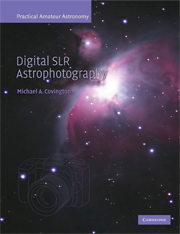14 - Techniques specific to astronomy
Published online by Cambridge University Press: 21 August 2009
Summary
This chapter presents a selection of image processing techniques that are more specific to astronomy. Again, vita brevis, ars longa – more techniques have been invented than any individual can master, and I make no attempt to be exhaustive.
You do not have to master every known technique in order to get good pictures. Keep in mind that there are many ways to achieve almost identical results. Indeed, in the next few years I expect a shakedown and simplification as astrophotographers unclutter their digital toolboxes.
Combining images
Why do we combine images? To build up the signal while rejecting the noise. The key idea is that the random noise is different in each image and therefore will partly cancel out when they are stacked (Figure 14.1). To be precise, the signal-to-noise ratio in the sum or average of √N images is times as good as in one image by itself.
How images are combined
Sum
The most obvious way to combine corresponding pixel values is to add them. This is like making a multiple exposure in a camera; every image contributes something to the finished product.
The problem with adding (summing) is that the resulting pixel values may be too high. If you are working with 16-bit pixels, then the maximum pixel value is 65 535; clearly, if you add two images that have 40 000 in the same pixel, the result, 80 000, will be out of range.
- Type
- Chapter
- Information
- Digital SLR Astrophotography , pp. 178 - 196Publisher: Cambridge University PressPrint publication year: 2007



